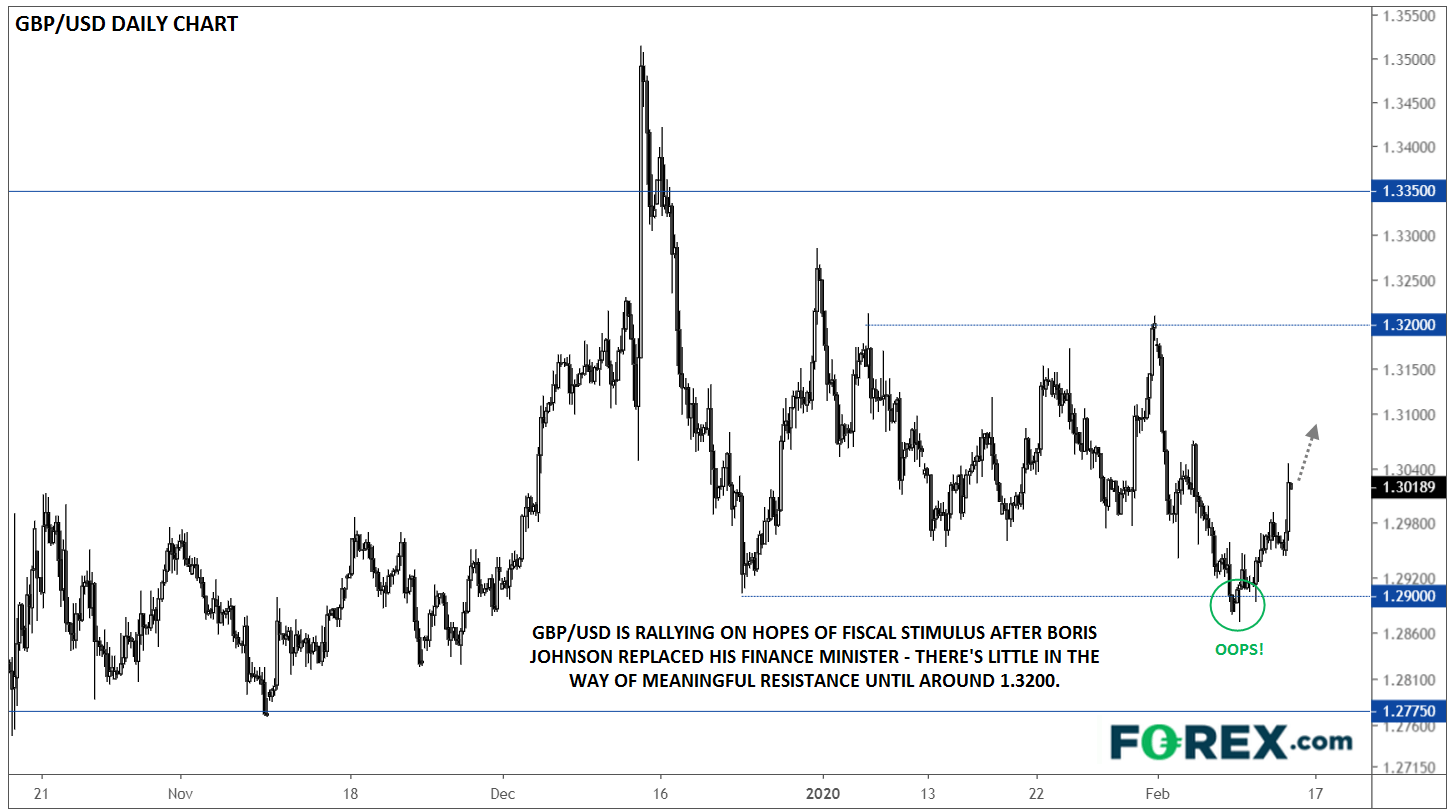Risk assets are taking a hit this morning after China announced a 15k surge in COVID-19 (coronavirus) cases following a new diagnostic protocol, reviving fears that the outbreak may be less contained than previously assumed. That said, current data suggests that COVID-19 is less deadly than previous epidemics and generally contained to China for the moment, though risk sentiment could take another tumble if either of these assumptions is called into question in the coming days. One way or another, the disruption to economic activity in China seems poised to stretch into March at this point.
Meanwhile, nearly 9,000km away in London, pound traders are more focused on domestic developments. Specifically, UK Prime Minister Boris Johnson made some significant changes to his cabinet, prominently including his replacement of Finance Minister Sajid David with Rishi Sunak. At first blush, market participants believe that Sunak would be less likely to show resistance to the Prime Minister and may be more likely to institute fiscal stimulus (read: tax cuts and spending increases) than his predecessor.
Expansionary fiscal policy remains the FX market’s proverbial “white whale” – with central banks increasingly resorting to untested (and so far fairly ineffective) policies across the developed world, many analysts believe that monetary policy is reaching the limits of its efficacy. Any signs that fiscal policy may be stepping up to take the baton are viewed as positive for the currency in question, and that’s why we’ve seen the pound rally to become the day’s strongest major currency.
Technically speaking, GBP/USD is rallying for its fourth consecutive day, but remains in the middle of its four-month range centered at 1.30. The pair seemingly saw a “false breakdown” below the late December low at 1.2900, wrongfooting shorts and setting the stage for the near-term rally:
Source: TradingView, GAIN Capital
Moving forward, GBP/USD could continue to see near-term strength, especially if Johnson and Sunak hint at expanding fiscal stimulus to address the UK’s lackluster growth. To the topside, there’s little in the way of meaningful previous resistance until the year-to-date highs around 1.3200. Any reversal to break below this week’s low at 1.2880 would eliminate the near-term bullish bias and increase the odds of a continuation to the bottom of the multi-month range at 1.2775.
This research is for informational purposes and should not be construed as personal advice. Trading any financial market involves risk. Trading on leverage involves risk of losses greater than deposits.
Recommended Content
Editors’ Picks
Bank of Japan keeps interest rate steady, as expected

The Bank of Japan (BoJ) board members decided to hold the key interest rate steady at 0%, following its April monetary policy review meeting on Friday. The decision came in line with the market expectations.
AUD/USD consolidates gains above 0.6500 after Australian PPI data

AUD/USD is consolidating gains above 0.6500 in Asian trading on Friday. The pair capitalizes on an annual increase in Australian PPI data. Meanwhile, a softer US Dollar and improving market mood also underpin the Aussie ahead of the US PCE inflation data.
Gold price keeps its range around $2,330, awaits US PCE data

Gold price is consolidating Thursday's rebound early Friday. Gold price jumped after US GDP figures for the first quarter of 2024 missed estimates, increasing speculation that the Fed could lower borrowing costs. Focus shifts to US PCE inflation on Friday.
Stripe looks to bring back crypto payments as stablecoin market cap hits all-time high

Stripe announced on Thursday that it would add support for USDC stablecoin, as the stablecoin market exploded in March, according to reports by Cryptocompare.
US economy: Slower growth with stronger inflation

The US Dollar strengthened, and stocks fell after statistical data from the US. The focus was on the preliminary estimate of GDP for the first quarter. Annualised quarterly growth came in at just 1.6%, down from the 2.5% and 3.4% previously forecast.
